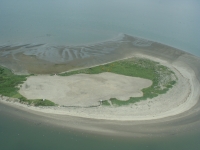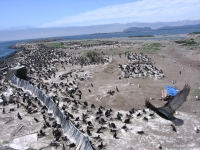 East Sand Island is a low-lying island near the mouth of the Columbia River in the Columbia River estuary just offshore from the small fishing village of Chinook (WA). East Sand Island is owned and managed by the U.S. Army Corps of Engineers and, despite its proximity to Washington, is in the state of Oregon. The 62-acre island has been greatly modified by human activities, but is situated close to the former location of a natural sandy island. Currently, East Sand Island is the site of the largest known nesting colonies of Caspian terns and double-crested cormorants in the world. Caspian terns first nested on East Sand Island in 1984 following the deposition of fresh dredged material at the eastern tip of the island in 1983. By 1985, vegetation covered the East Sand Island nesting site, and by 1986 the tern colony had shifted to Rice Island, a large, sandy dredged material disposal site 16 miles further up-river. After a period of rapid growth in the size of the Rice Island tern colony during the late 1980’s and early 1990’s, resource managers implemented a plan to relocate the Rice Island tern colony to restored tern nesting habitat on the eastern tip of East Sand Island. This management plan was based on the expectation that Caspian terns nesting on East Sand Island would rely less on juvenile salmonids as a food source than Caspian terns nesting on Rice Island. The management action was successful in relocating the tern colony in its entirety from Rice Island to East Sand Island by 2001; since 2001 all Caspian terns nesting in the Columbia River estuary have nested on East Sand Island (approximately 8,300 breeding pairs in 2010). In 2008, the U.S. Army Corps of Engineers began implementing the plan “Caspian Tern Management to Reduce Predation of Juvenile Salmonids in the Columbia River Estuary,” outlined in the Final Environmental Impact Statement (FEIS) and Records of Decision (RODs) signed in November 2006. This management plan seeks to redistribute at least half of the East Sand Island Caspian tern colony to alternative colony sites in Oregon and California by 2015.
East Sand Island is a low-lying island near the mouth of the Columbia River in the Columbia River estuary just offshore from the small fishing village of Chinook (WA). East Sand Island is owned and managed by the U.S. Army Corps of Engineers and, despite its proximity to Washington, is in the state of Oregon. The 62-acre island has been greatly modified by human activities, but is situated close to the former location of a natural sandy island. Currently, East Sand Island is the site of the largest known nesting colonies of Caspian terns and double-crested cormorants in the world. Caspian terns first nested on East Sand Island in 1984 following the deposition of fresh dredged material at the eastern tip of the island in 1983. By 1985, vegetation covered the East Sand Island nesting site, and by 1986 the tern colony had shifted to Rice Island, a large, sandy dredged material disposal site 16 miles further up-river. After a period of rapid growth in the size of the Rice Island tern colony during the late 1980’s and early 1990’s, resource managers implemented a plan to relocate the Rice Island tern colony to restored tern nesting habitat on the eastern tip of East Sand Island. This management plan was based on the expectation that Caspian terns nesting on East Sand Island would rely less on juvenile salmonids as a food source than Caspian terns nesting on Rice Island. The management action was successful in relocating the tern colony in its entirety from Rice Island to East Sand Island by 2001; since 2001 all Caspian terns nesting in the Columbia River estuary have nested on East Sand Island (approximately 8,300 breeding pairs in 2010). In 2008, the U.S. Army Corps of Engineers began implementing the plan “Caspian Tern Management to Reduce Predation of Juvenile Salmonids in the Columbia River Estuary,” outlined in the Final Environmental Impact Statement (FEIS) and Records of Decision (RODs) signed in November 2006. This management plan seeks to redistribute at least half of the East Sand Island Caspian tern colony to alternative colony sites in Oregon and California by 2015.
 Nesting by double-crested cormorants on East Sand Island was first recorded in 1989, when 90 active nests were detected at the western tip of the island; since then the colony has grown to ca. 13,600 breeding pairs by 2010. Amidst the double-crested cormorant colony a small colony of Brandt’s cormorants (nearly 1,000 nesting pairs in 2010) has developed. There is also a large colony of glaucous-winged/western gulls, consisting of nearly 5,000 breeding pairs, that has developed on East Sand Island in the last 25 years, joined more recently by a colony of ca. 1,700 pairs of ring-billed gulls. Nearly 17,000 California brown pelicans have been observed roosting on East Sand Island, making it the largest nighttime roost for this species anywhere on the Pacific coast of the United States. Because of the large numbers of nesting and roosting colonial waterbirds on East Sand Island, the island has been designated an Important Bird Area by the American Bird Conservancy.
Nesting by double-crested cormorants on East Sand Island was first recorded in 1989, when 90 active nests were detected at the western tip of the island; since then the colony has grown to ca. 13,600 breeding pairs by 2010. Amidst the double-crested cormorant colony a small colony of Brandt’s cormorants (nearly 1,000 nesting pairs in 2010) has developed. There is also a large colony of glaucous-winged/western gulls, consisting of nearly 5,000 breeding pairs, that has developed on East Sand Island in the last 25 years, joined more recently by a colony of ca. 1,700 pairs of ring-billed gulls. Nearly 17,000 California brown pelicans have been observed roosting on East Sand Island, making it the largest nighttime roost for this species anywhere on the Pacific coast of the United States. Because of the large numbers of nesting and roosting colonial waterbirds on East Sand Island, the island has been designated an Important Bird Area by the American Bird Conservancy.



